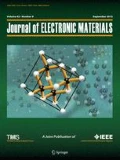Abstract
Electrical conductivity deterioration of polyaniline (PANI) at elevated temperatures has limited its applications for commercial usages. In this study we endeavored to improve the thermal aging resistance of PANI and its conductivity stability at elevated temperatures using a high molecular weight dopant, dodecylbenzenesulfonic acid (DBSA), along with the addition of carbon-based nanoparticles. DBSA-doped PANI (DBSA-PANI) and its nanocomposites with graphene oxide (PANI/GO) and multi-walled carbon nanotube (PANI/MWCNT) were prepared through in situ polymerization. The samples were aged at 90°C up to 1000 h and characterized by Fourier transform infrared spectroscopy (FTIR), x-ray diffraction (XRD), scanning electron microscopy (SEM), and electrical conductivity measurements. It was observed that electrical conductivity deteriorates more rapidly in DBSA-PANI than in GO and MWCNT nanocomposites. The FTIR results confirmed a strong retention of DBSA groups in the nanocomposites after aging, but not for DBSA-PANI. This showed more stability of DBSA dopant in PANI/GO and PANI/CNT. The characteristic time (τ), as a criterion for thermal stability, was found to be 91, 172, and 295 h for DBSA-PANI, PANI/MWCNT, and PANI/GO, respectively. It was suggested that the retardation of the de-doping process is the major reason for the higher τ value and more electrical conductivity stability of PANI/GO. The obtained thermal stability for the electrical conductivity of DBSA doped PANI/GO nanocomposites was nearly 30 times higher than that of HCl-doped PANI.
Similar content being viewed by others
References
S. Bhadra, D. Khastgir, N.K. Singha, and J.H. Lee, Prog. Polym. Sci. 34, 783 (2009).
Y. Luo, R. Guo, T. Li, F. Li, Z. Liu, M. Zheng, B. Wang, Z. Yang, H. Luo, and Y. Wan, Chemsuschem 12, 1591 (2018).
M.K. Yazdi, H. Saeidi, P. Zarrintaj, M.R. Saeb, and M. Mozafari, In Fundamentals and Emerging Applications of Polyaniline, 1st ed. (San Diego: Elsevier, 2019), pp. 121–130.
K.-H. Park, S.J. Kim, R. Gomes, and A. Bhaumik, Chem. Eng. J. 260, 393 (2015).
M. Hosseinnezhad, K. Gharanjig, M.K. Yazdi, P. Zarrintaj, S. Moradian, M.R. Saeb, and F.J. Stadler, J. Alloys Compd. 828, 154329 (2020).
J. Chu, D. Lu, B. Wu, X. Wang, M. Gong, R. Zhang, and S. Xiong, Sol. Energy Mater. Sol. Cells 177, 70 (2018).
A.I. Khadieva, V.V. Gorbachuk, G.A. Evtugyn, S.V. Belyakova, R.R. Latypov, S.V. Drobyshev, and I.I. Stoikov, Sci. Rep. 9, 1 (2019).
S. Qiu, C. Chen, W. Zheng, W. Li, H. Zhao, and L. Wang, Synth. Met. 229, 39 (2017).
A. Chiolerio, S. Bocchini, F. Scaravaggi, S. Porro, D. Perrone, D. Beretta, M. Caironi, and C.F. Pirri, Semicond. Sci. Technol. 30, 104001 (2015).
P. Zarrintaj, M.K. Yazdi, H. Vahabi, P.N. Moghadam, and M.R. Saeb, Prog. Org. Coat. 130, 144 (2019).
J.L. Brédas and R. Silbey, In Conjugated polymers: the novel science and technology of highly conducting and nonlinear optically active materials. (Springer, Berlin 2012).
Z. Zhang, Z. Wei, and M. Wan, Macromol. 35, 5937 (2002).
M.V. Kulkarni, A.K. Viswanath, R. Marimuthu, and T. Seth, Polym. Eng. Sci. 44, 1676 (2004).
M.K. Yazdi, G.H. Motlagh, S.S. Garakani, and A. Boroomand, J. Polym. Res. 25, 265 (2018).
M. Khalid, M.A. Tumelero, I. Brandt, V.C. Zoldan, J.J. Acuña, and A.A. Pasa, Indian J. Eng. Mater. Sci. 2013, 1 (2013).
L. Ren, G. Zhang, H. Li, D. Hu, and S. Dou, Int. J. Electrochem. Sci. 14, 238 (2019).
M.G. Han, S.K. Cho, S.G. Oh, and S.S. Im, Synth. Met. 126, 53 (2002).
P. Zarrintaj, M.K. Yazdi, M. Jouyandeh, and M.R. Saeb, In Fundamentals and Emerging Applications of Polyaniline, 1st ed. (San Diego: Elsevier, 2019), pp. 143–163.
M.M. Nobrega, C.M. Izumi, and M.L. Temperini, Polym. Degrad. Stab. 113, 66 (2015).
J. Prokeš and J. Stejskal, Polym. Degrad. Stab. 86, 187 (2004).
I. Šeděnková, M. Trchova, and J. Stejskal, Polym. Degrad. Stab. 93, 2147 (2008).
M. Trchová, I. Šeděnková, E. Tobolková, and J. Stejskal, Polym. Degrad. Stab. 86, 179 (2004).
T. Chen, C. Dong, X. Li, and J. Gao, Polym. Degrad. Stab. 94, 1788 (2009).
S. Sakkopoulos, E. Vitoratos, E. Dalas, N. Kyriakopoulos, P. Malkaj, and T. Argyreas, J. Appl. Polym. Sci. 97, 117 (2005).
I. Šeděnková, J. ProkeŠ, M. Trchová, and J. Stejskal, Polym. Degrad. Stab. 93, 428 (2008).
M.O. Ansari and F. Mohammad, Compos. Part B-Eng. 43, 3541 (2012).
X. Lu, H.Y. Ng, J. Xu, and C. He, Synth. Met. 128, 167 (2002).
J. Stejskal, M. Omastova, S. Fedorova, J. Prokeš, and M. Trchová, Polymer 44, 1353 (2003).
M. Khodadadi Yazdi and G. Hashemi Motlagh, J Appl Polym Sci, vol. 134, 44635 (2017).
X. Cheng, V. Kumar, T. Yokozeki, T. Goto, T. Takahashi, J. Koyanagi, L. Wu, and R. Wang, Compos. Part A Appl. Sci. Manuf. 82, 100 (2016).
R. Kumar, M.O. Ansari, and M. Barakat, Chem. Eng. J. 228, 748 (2013).
N.A. Ogurtsov, Y.V. Noskov, V.N. Bliznyuk, V.G. Ilyin, J.-L. Wojkiewicz, E.A. Fedorenko, and A.A. Pud, J. Phys. Chem. C 120, 230 (2015).
W. Gao, In Graphene oxide, (Springer: 2015).
M.S. Khan and Z. Ali, Chin. J. Polym. Sci. 23, 29 (2005).
G. Nikravan, G. Motlagh, A. Foroozani, and S. Motahari, Cell. Polym. 35, 329 (2016).
V. Kumar, R. Mahajan, I. Kaur, and K.-H. Kim, ACS Appl Mater Inter 9, 16813 (2017).
S. Bachhav and D. Patil, Am J Mater Sci 5, 90 (2015).
T.-H. Le, Y. Kim, and H. Yoon, Polymers 9, 150 (2017).
Acknowledgments
The authors would like to thank Ali Boroomand who was the first student in our APMP Lab to synthesize polyaniline and its CNT nanocomposite.
Author information
Authors and Affiliations
Corresponding author
Additional information
Publisher's Note
Springer Nature remains neutral with regard to jurisdictional claims in published maps and institutional affiliations.
Rights and permissions
About this article
Cite this article
Khodadadi Yazdi, M., Hashemi Motlagh, G. Improved Electrical and Thermal Aging Properties of DBSA-Doped PANI Using MWCNT and GO. J. Electron. Mater. 49, 5326–5334 (2020). https://doi.org/10.1007/s11664-020-08256-x
Received:
Accepted:
Published:
Issue Date:
DOI: https://doi.org/10.1007/s11664-020-08256-x




